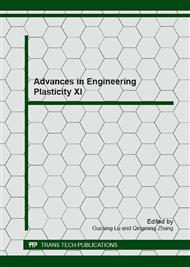p.137
p.141
p.147
p.152
p.156
p.160
p.164
p.168
p.173
Comparison Investigation of Tensile Fracture Properties of Al Alloy at Different Dynamic Loadings
Abstract:
Spall Strength, uniaxial tensile strength and fracture toughness, are three typical parameters describing the fracture properties of materials subjected to different loadings. Actually, these three macroscopically parameters are connected to the tensile fracture (Model I) properties, and many papers have been trying to find the intrinsic connection between each other. In this work, ZL205A aluminum is conducted by varies experiments: the spallation test loaded by a light gas gun, the dynamic uniaxial tensile test using the Split Hopkinson Tensile Bars (SHTB), and the dynamic fracture toughness obtained with a three point bending specimen loaded by Split Hopkinson Pressure Bars (SHPB). The three parameters are compared with the view of energy. The results show that the cavity expansion model is successfully used to set up a connection between spallation strength and dynamic uniaxial tensile strength of this material, while the energy release rate or the surface energy can give a good prediction of dynamic tensile strength and fracture toughness.
Info:
Periodical:
Pages:
156-159
Citation:
Online since:
January 2013
Authors:
Keywords:
Price:
Сopyright:
© 2013 Trans Tech Publications Ltd. All Rights Reserved
Share:
Citation:


